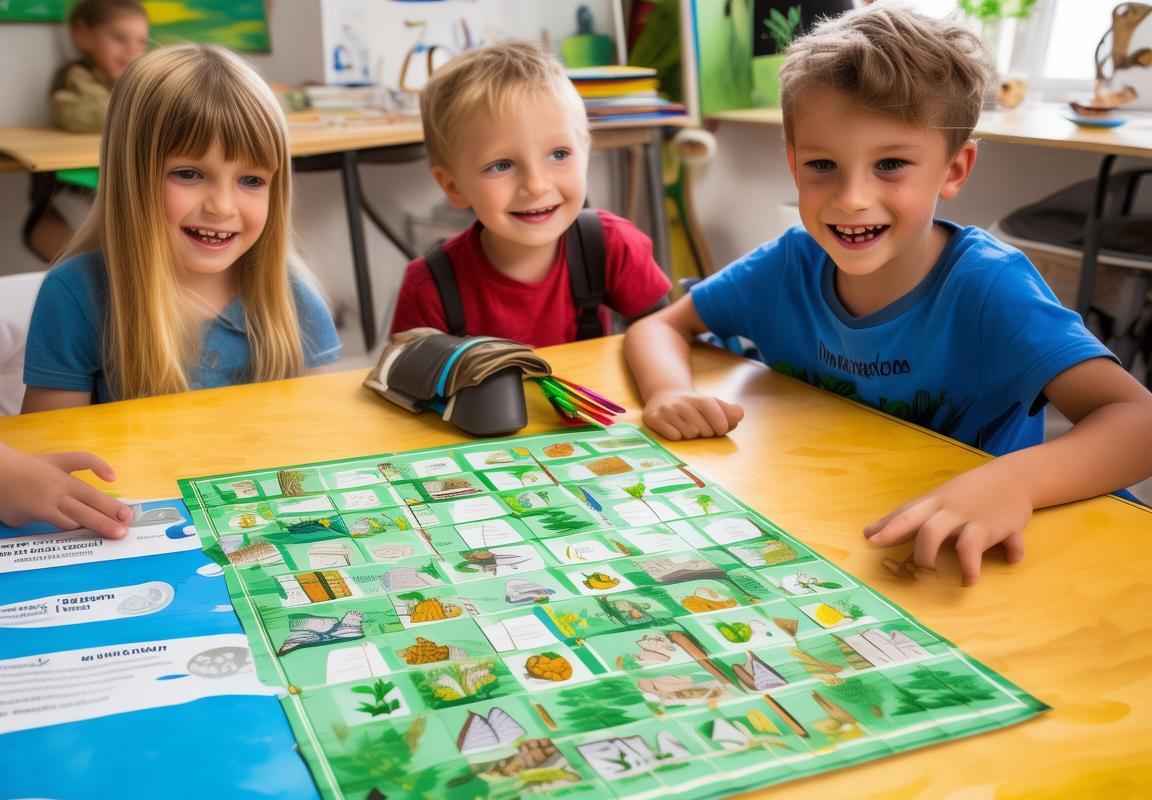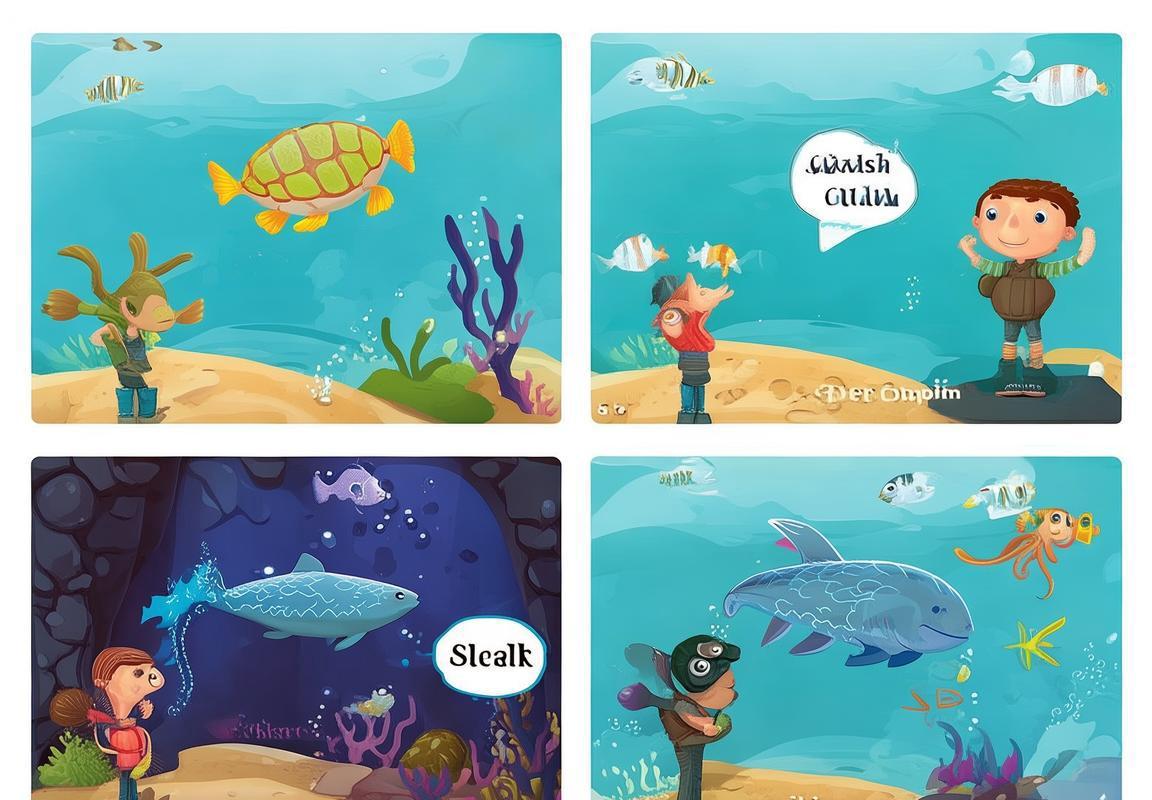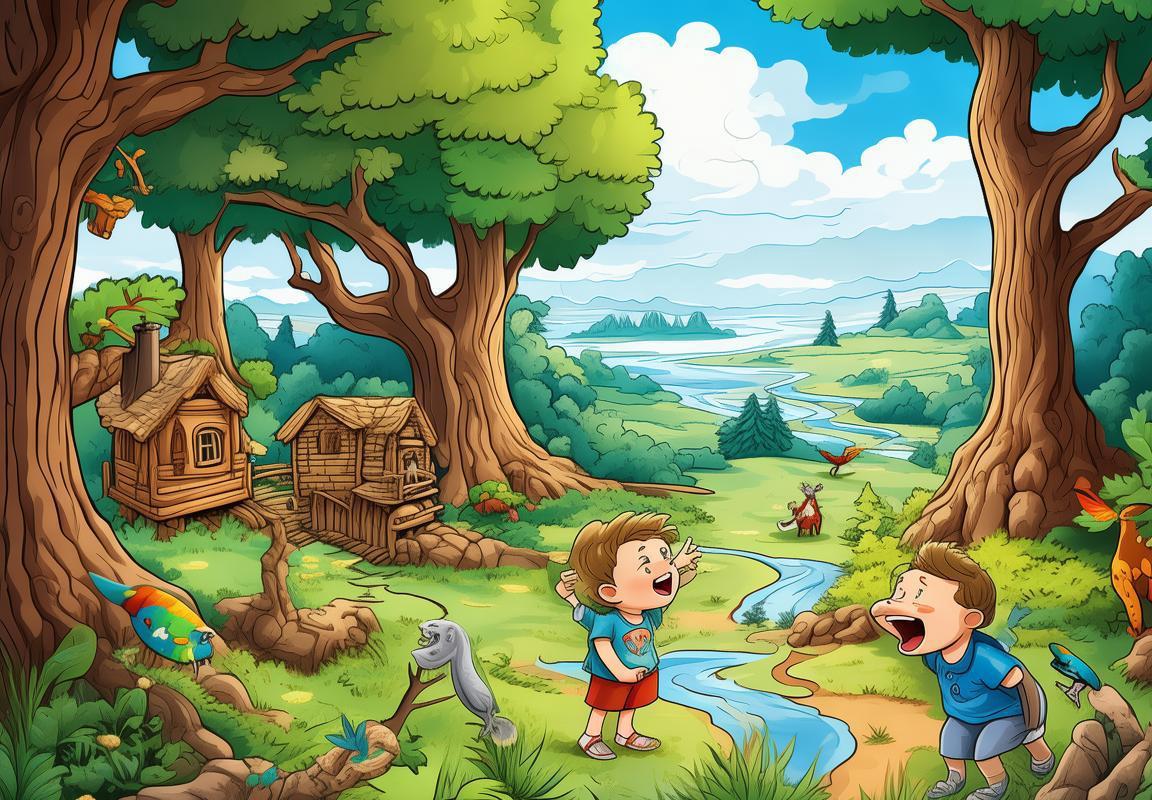เรามีกำหนดเรียนรู้เกี่ยวกับภาษาอังกฤษสำหรับเด็กโดยผสมผสานกับเรื่องราวและเล่นเกมที่น่าสนใจ นี่จะช่วยเด็กสร้างความสนใจและความเข้าใจในภาษาอังกฤษอย่างง่ายต่อยอด!
หน้าแรก: ภาพแนวทาง
In this game, children will have to search for hidden English words related to the environment. Here’s how the game can be structured:
- Game Setup
- Choose a theme related to the environment, such as “The Forest,” “The Beach,” or “The City.”
- Create a grid with words related to the chosen theme hidden within it. These words can be horizontal, vertical, diagonal, or even backwards.
- Word Grid
- The grid should be large enough to include multiple words. For example, a 5×5 grid can be used for younger children, while an 8×8 grid is more suitable for older children.
- Words can range from simple, like “tree” or “beach,” to more complex ones like “ecosystem” or “ocean.”
- Finding the Words
- The children must search the grid for the hidden words. They can do this by following the letters of the word or by guessing the word based on the letters they find.
- As they find each word, they should write it down on a separate sheet or in a special section of the grid.
- Reinforcement
- Once a word is found, children can read it aloud to reinforce their pronunciation and spelling skills.
- They can also draw a small picture next to each word to help them remember it.
- Challenges
- To make the game more interactive, you can include challenges such as:
- Finding words that start with a specific letter or sound.
- Finding words that end with a specific letter or sound.
- Finding words that are the longest or shortest in the grid.
- Reward
- After finding all the words, children can receive a small reward or treat, or they can share their findings with the rest of the class.
- Example Words
- For a “Forest” theme: tree, leaf, bird, river, animal.
- For a “Beach” theme: sand, wave, shell, sea, boat.
- For a “City” theme: car, building, street, people, traffic.
- Conclusion
- After the game, children can discuss what they learned about the environment and how the words they found relate to it.
- They can also create a small display or poster with the words they found to show their classmates.
This game not only helps children learn new vocabulary related to the environment but also encourages them to engage with the language through fun and interactive activities.

หน้าที่ 2: หาคำศัพท์
เริ่มจากภาพแนวทางที่มีสัตว์น้ำต่างๆ ซ่อนอยู่ โดยให้เด็กดูและค้นหาคำศัพท์ที่เกี่ยวข้องกับสัตว์น้ำดังนี้:
- ภาพปลา: Fish, turtle, shark, dolphin, octopus
- ภาพปลาน้ำเข้ม ซ่อนคำศัพท์ “Fish”
- ภาพหมึก ซ่อนคำศัพท์ “Octopus”
- ภาพปลาฝัง ซ่อนคำศัพท์ “Shark”
- ภาพปลาดอลฟิน ซ่อนคำศัพท์ “Dolphin”
- ภาพหมึก ซ่อนคำศัพท์ “Turtle”
- ภาพสัตว์น้ำต่างๆ:
- ภาพปลาที่กินปลาเล็ก ซ่อนคำศัพท์ “Small fish”
- ภาพปลาที่หลงตัว ซ่อนคำศัพท์ “Lost”
- ภาพปลาที่หลับหมอบ ซ่อนคำศัพท์ “Sleeping”
- ภาพปลาที่เล่นกับเตะ ซ่อนคำศัพท์ “Playing”
- ภาพปลาที่วิ่ง ซ่อนคำศัพท์ “Running”
เด็กต้องหาคำศัพท์ที่ซ่อนอยู่และเขียนมันลงในบล็อคที่กำหนด หลังจากนั้น ยังมีกิจกรรมตัวอย่างต่อไปนี้:
- จำแนกภาพ: ภาพทะเลที่มีปลาต่างๆ ซ่อนอยู่ โดยเด็กต้องจำแนกเป็นส่วนที่เกี่ยวข้อง เช่น ปลา, หมึก, ลำธาร, และดินแดน
- แบบทบทวนคำศัพท์: คำศัพท์ที่หามาแล้วเขียนเป็นแบบทบทวน เช่น “The fish (is/are) in the water.”
ประเมินผล:- คะแนนจะได้จากจำนวนคำศัพท์ที่หามาทั้งหมด- คะแนนจะได้จากความแน่ใจในการจำแนกภาพและแบบทบทวนคำศัพท์
เป้าหมาย:- ฝึกความสามารถในการหาคำศัพท์และจำแนกภาพ- สร้างความสนใจในภาษาอังกฤษผ่านการเล่นเกม

หน้าที่ 3: คำถามแบบทบทวน
- คำถามเรื่องสัตว์
- “What animal is this?” (ภาพสัตว์แมว)
- “What does the bear say?” (เสียงสัตว์หมี)
- “Can you find the fish?” (ภาพปลา)
- คำถามเรื่องสิ่งแวดล้อม
- “Where is the tree?” (ภาพไม้)
- “What is the color of the sun?” (เสียงแดด)
- “What do you see in the ocean?” (ภาพทะเล)
- คำถามเรื่องวันและเวลา
- “What time is it?” (ภาพนาฬิกา)
- “What day is today?” (ภาพวัน)
- “What season is it?” (เสียงฤดู)
- คำถามเรื่องกิจกรรม
- “What are they doing?” (ภาพหลายรูปที่แสดงกิจกรรมต่างๆ)
- “What do you play with?” (ภาพของเล่น)
- “What do you eat?” (ภาพอาหาร)
- คำถามเรื่องเครื่องมือ
- “What is this?” (ภาพเครื่องมือต่างๆ)
- “How do you use this?” (เสียงที่แสดงวิธีใช้งานเครื่องมือ)
- คำถามเรื่องการเดินทาง
- “How do you go to school?” (ภาพที่แสดงวิธีเดินทาง)
- “What do you see on the bus?” (ภาพที่ต่างๆ ในรถบัส)
- “Where do you go on holidays?” (ภาพที่แสดงสถานที่เล่น)
- คำถามเรื่องการดูแลตัวเอง
- “How do you take care of yourself?” (ภาพที่แสดงกิจกรรมดูแลตัวเอง)
- “What do you do when you are tired?” (เสียงที่แสดงกิจกรรมเมื่อเล็งเหน็ด)
- “How do you clean your room?” (ภาพที่แสดงวิธีทำความสะอาดห้อง)
- คำถามเรื่องกีฬา
- “What sport do you like?” (ภาพกีฬาต่างๆ)
- “How do you play this game?” (เสียงที่แสดงวิธีเล่นเกม)
- “What do you win in the race?” (ภาพที่แสดงรางวัล)
- คำถามเรื่องดาวและดวงจันทร์
- “What is the moon?” (ภาพดวงจันทร์)
- “What is the star?” (ภาพดาว)
- “Where are they?” (เสียงที่แสดงสถานที่ของดาวและดวงจันทร์)
- คำถามเรื่องดาวเคราะห์และจักรวาล
- “What is a planet?” (ภาพดาวเคราะห์)
- “What is the universe?” (เสียงที่แสดงจักรวาล)
- “What do you find

หน้าที่ 4: ภาพแบบทบทวน
- ภาพป่า: ให้เด็กจำแนกภาพป่าเป็นส่วนที่เกี่ยวข้อง อย่างเช่น:
- ต้นไม้ (tree)
- นก (bird)
- หมู่เรือน (house)
- แม่น้ำ (river)
- ภาพทะเล: ให้เด็กจำแนกภาพทะเลเป็นส่วนที่เกี่ยวข้อง อย่างเช่น:
- ฝูงปลา (school of fish)
- ลำธาร (beach)
- ลำทราย (sand)
- ปั้นเรือ (ship)
- ภาพเมือง: ให้เด็กจำแนกภาพเมืองเป็นส่วนที่เกี่ยวข้อง อย่างเช่น:
- ถนน (street)
- ร้านเมือง (shop)
- รถยนต์ (car)
- ตึกสูง (building)
- ภาพสวนสัตว์: ให้เด็กจำแนกภาพสวนสัตว์เป็นส่วนที่เกี่ยวข้อง อย่างเช่น:
- สระปลา (pond)
- ลิง (monkey)
- แรด (elephant)
- แก้ว (giraffe)
- ภาพห้องสมุด: ให้เด็กจำแนกภาพห้องสมุดเป็นส่วนที่เกี่ยวข้อง อย่างเช่น:
- หนังสือ (book)
- ต้นไม้ (tree)
- หน้าต่าง (window)
- โต้น (chair)
- ภาพห้องนอน: ให้เด็กจำแนกภาพห้องนอนเป็นส่วนที่เกี่ยวข้อง อย่างเช่น:
- เตียง (bed)
- กระเป๋า (bag)
- รายละเอียด (details) อื่น ๆ
- ภาพห้องประกอบ: ให้เด็กจำแนกภาพห้องประกอบเป็นส่วนที่เกี่ยวข้อง อย่างเช่น:
- โทรทัศน์ (television)
- แฟรนไซส์ (fridge)
- แอร์คอนดิชเนอร์ (air conditioner)
- โต๊ะ (table)
- ภาพห้องและหน้าต่าง: ให้เด็กจำแนกภาพห้องและหน้าต่างเป็นส่วนที่เกี่ยวข้อง อย่างเช่น:
- หน้าต่าง (window)
- โซนที่อยู่อาศัย (living room)
- ห้องนอน (bedroom)
- ห้องที่อยู่อาศัย (kitchen)
- ภาพห้องภายนอก: ให้เด็กจำแนกภาพห้องภายนอกเป็นส่วนท

หน้าที่ 5: แบบทบทวนคำศัพท์
-
ภาพแรก: ภาพของหมาป่าที่อยู่ในป่าและภาพของหมาป่าที่อยู่ในห้องแรม
-
คำศัพท์: “wolf”
-
คำถาม: “What is the animal that lives in the forest?”
-
คำตอบ: “A wolf.”
-
ภาพที่ 2: ภาพของแร่และภาพของเจ้าหนู
-
คำศัพท์: “stone”
-
คำถาม: “What is the hard thing that we find in the ground?”
-
คำตอบ: “A stone.”
-
ภาพที่ 3: ภาพของแก้วและภาพของแก้วที่มีสี
-
คำศัพท์: “cup”
-
คำถาม: “What is the container we use to drink water?”
-
คำตอบ: “A cup.”
-
ภาพที่ 4: ภาพของหมอกและภาพของทางที่มีหมอก
-
คำศัพท์: “cloud”
-
คำถาม: “What is the white thing in the sky?”
-
คำตอบ: “A cloud.”
-
ภาพที่ 5: ภาพของหมองและภาพของหมองที่มีเสียง
-
คำศัพท์: “noise”
-
คำถาม: “What is the sound that makes us happy?”
-
คำตอบ: “Noise.”
-
ภาพที่ 6: ภาพของหมองและภาพของหมองที่มีสี
-
คำศัพท์: “color”
-
คำถาม: “What is the thing that makes things look beautiful?”
-
คำตอบ: “Color.”
-
ภาพที่ 7: ภาพของหมองและภาพของหมองที่มีรสชาติ
-
คำศัพท์: “taste”
-
คำถาม: “What is the thing that makes our food delicious?”
-
คำตอบ: “Taste.”
-
ภาพที่ 8: ภาพของหมองและภาพของหมองที่มีกลิ่น
-
คำศัพท์: “smell”
-
คำถาม: “What is the thing that makes us smell good?”
-
คำตอบ: “Smell.”
-
ภาพที่ 9: ภาพของหมองและภาพของหมองที่มีรส
-
คำศัพท์: “touch”
-
คำถาม: “What is the thing that makes us feel soft?”
-
คำตอบ: “Touch.”
-
ภาพที่ 10: ภาพของหมองและภาพของหมองที่มีเสียง
-
คำศัพท์: “sound”
-
คำถาม: “What is the thing that makes us hear?”
-
คำตอบ: “Sound.”
-
ภาพที่ 11: ภาพของหมองและภาพของหมองที่มีสี
-
คำศ
